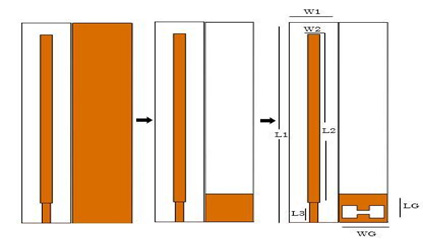Wireless power transfer through mutual coupling using monopole antennas
Transferencia de energía inalámbrica a través de acoplamiento mutuo usando antenas monopolo


This work is licensed under a Creative Commons Attribution-NonCommercial-NoDerivatives 4.0 International License.
Copyright statement
The authors exclusively assign to the Universidad EIA, with the power to assign to third parties, all the exploitation rights that derive from the works that are accepted for publication in the Revista EIA, as well as in any product derived from it and, in in particular, those of reproduction, distribution, public communication (including interactive making available) and transformation (including adaptation, modification and, where appropriate, translation), for all types of exploitation (by way of example and not limitation : in paper, electronic, online, computer or audiovisual format, as well as in any other format, even for promotional or advertising purposes and / or for the production of derivative products), for a worldwide territorial scope and for the entire duration of the rights provided for in the current published text of the Intellectual Property Law. This assignment will be made by the authors without the right to any type of remuneration or compensation.
Consequently, the author may not publish or disseminate the works that are selected for publication in the Revista EIA, neither totally nor partially, nor authorize their publication to third parties, without the prior express authorization, requested and granted in writing, from the Univeridad EIA.
Show authors biography
Wireless power transfer using near-field inductive coupling has been employed in several applications, including wireless charging of electronic devices and powering of implanted biomedical devices. In these applications, power is transferred over short distances, which are much smaller than the operating wavelength. In these systems, the link power transfer efficiency is inversely related to the operating range. This paper focuses on the design and investigation of a pair of equal-dimensional microstrip antennas, one of which is excited by a pulse emitted using GNU Radio software and USRP 2901. The proposed pair of devices consists of two monopoles with faulty ground the sizes, 16 mm × 116 mm, which act as transmitter and receiver respectively. The devices have been designed, simulated, and optimized using CST Microwave Studio software. The surface current results of the coupled devices indicate good current density over a distance range of 10 mm to 50 mm.
Article visits 512 | PDF visits 270
Downloads
- Ammann, M. J., and Zhi Ning Chen. 2003. “Wideband Monopole Antennas for Multi-Band Wireless Systems.” IEEE Antennas and Propagation Magazine 45(2): 146–50. https://doi.org/10.1109/map.2003.1203133
- Anob, P. V., K. P. Ray, and G. Kumar. 2001. “Wideband Orthogonal Square Monopole Antennas with Semi-Circular Base.” IEEE Antennas and Propagation Society, AP-S International Symposium (Digest) 3: 294–97. https://doi.org/10.1109/aps.2001.960090
- Burrus, C A A T, and T Bell Laboratories. 1993. “M. Hammoud, P. Poey and F. Colombel.” 29(4). https://doi.org/10.1049/el:19930272
- Chhawchharia, Saransch et al. 2018. “Investigation of Wireless Power Transfer Applications with a Focus on Renewable Energy.” Renewable and Sustainable Energy Reviews 91(April): 888–902. https://doi.org/10.1016/j.rser.2018.04.101
- Da Silva, Erik Farias, Alfredo Gomes Neto, and Custódio Peixeiro. 2019. “Fast and Accurate Rectenna Design Method.” IEEE Antennas and Wireless Propagation Letters 18(5): 886–90. https://doi.org/10.1109/lawp.2019.2904795
- Feng, Junjie, Qiang Li, and Fred C. Lee. 2018. “Coil and Circuit Design of Omnidirectional Wireless Power Transfer System for Portable Device Application.” 2018 IEEE Energy Conversion Congress and Exposition, ECCE 2018: 914–20. https://doi.org/10.1109/ecce.2018.8557465
- Kamo, Bexhet, Shkelzen Cakaj, Vladi Koliçi, and Erida Mulla. 2012. “Simulation and Measurements of VSWR for Microwave Communication Systems.” Network and System Sciences 5: 767–73. http://dx.doi.org/10.4236/ijcns.2012.511080PublishedOnlineNovember2012 (April 14, 2021). https://doi.org/10.4236/ijcns.2012.511080
- Khandelwal, Mukesh Kumar, Binod Kumar Kanaujia, and Sachin Kumar. 2017. “Defected Ground Structure: Fundamentals, Analysis, and Applications in Modern Wireless Trends.” International Journal of Antennas and Propagation 2017. https://doi.org/10.1155/2017/2018527
- Kim, Hongseok et al. 2016. “Coil Design and Measurements of Automotive Magnetic Resonant Wireless Charging System for High-Efficiency and Low Magnetic Field Leakage.” : 1–18. https://doi.org/10.1109/wpt.2015.7140180
- Kim, Youngsub, Young Joong Yoon, Jinwoo Shin, and Joonho So. 2014. “X-Band Printed Rectenna Design and Experiment for Wirelss Power Transfer.” In IEEE Wireless Power Transfer Conference 2014, IEEE WPTC 2014, IEEE Computer Society, 292–95. https://doi.org/10.1109/wpt.2014.6839566
- Li, Cheng Jyun, and Tai Cheng Lee. 2014. “2.4-GHz High-Efficiency Adaptive Power.” IEEE Transactions on Very Large Scale Integration (VLSI) Systems 22(2): 434–38. https://doi.org/10.1109/tvlsi.2013.2238264
- Lu, Jia Jun, Xue Xia Yang, Huan Mei, and Chong Tan. 2016. “A Four-Band Rectifier with Adaptive Power for Electromagnetic Energy Harvesting.” IEEE Microwave and Wireless Components Letters 26(10): 819–21. https://doi.org/10.1109/lmwc.2016.2601294
- Mohd Salleh, Mohd Hidir, Norhudah Seman, Dyg Norkhairunnisa Abang Zaidel, and Akaa Agbaeze Eteng. 2017. “Investigation of Unequal Planar Wireless Electricity Device for Efficient Wireless Power Transfer.” Radioengineering 26(1): 251–57. https://doi.org/10.13164/re.2017.0251
- Nikravan, M. A., and Z. Atlasbaf. 2011. “T-Section Dual-Band Impedance Transformer for Frequency-Dependent Complex Impedance Loads.” Electronics Letters 47(9): 551–53. https://doi.org/10.1049/el.2010.7452
- Selva, A. F.B. et al. 2012. “Introduction to the Software-Defined Radio Approach.” IEEE Latin America Transactions 10(1): 1156–61. https://doi.org/10.1002/0470867728.part1
- Strassner, Bernd, and Kai Chang. 2013. “Microwave Power Transmission: Historical Milestones and System Components.” Proceedings of the IEEE 101(6): 1379–96. https://doi.org/10.1109/jproc.2013.2246132
- Yang, Xiaodong, Wen Geyi, and Hucheng Sun. 2017. “Optimum Design of Wireless Power Transmission System Using Microstrip Patch Antenna Arrays.” IEEE Antennas and Wireless Propagation Letters 16: 1824–27. https://doi.org/10.1109/lawp.2017.2682262
- Yu, Xiaofang et al. 2013. “Wireless Power Transfer in the Presence of Metallic Plates: Experimental Results.” AIP Advances 3(6): 0–9. https://doi.org/10.1063/1.4809665
- Zhang, Wei, Jeff C White, Rajesh K Malhan, and Chunting Chris Mi. 2016. “Loosely Coupled Transformer Coil Design to Minimize EMF Radiation in Concerned Areas.” XX(X). https://doi.org/10.1109/tvt.2016.2535272
- Zhong, Wenxing, and S Y R Hui. 2014. “Maximum Energy Efficiency Tracking for Wireless Power Transfer Systems.” 8993(c). https://doi.org/10.1109/tpel.2014.2351496




